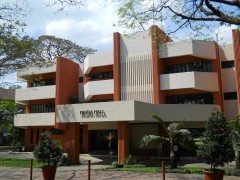Ateneo Physics Department approves Physics Education as a new research field for MS and PhD in Physics students
March 2, 2013 1 Comment

Dr. Minella Alarcon (far left) and Mr. Ivan Culaba (center) observe Ateneo high school physics teachers making an experiment on linear motion
Last February 1, 2013, the Department of Physics of Ateneo de Manila University unanimously approved the designation of Physics Education as one of the department’s research areas. This means that students enrolled either in M.S. in Physics and Ph.D. in Physics can now take Physics Education research as their thesis or dissertation topic, as done in reputable US universities like University of Maryland, University of Colorado, and University of WashingtonThe main proponent of Physics Education research is Prof. Minella Alarcon who led the ALOP (Active Learning in Optics and Photonics) team during her stay at UNESCO prior to her return to Ateneo de Manila University in 2011. The ALOP team is composed of 8 international physicists who conduct optics education seminars to more than 400 physics teachers in more than 45 countries. Two members of the ALOP team are Ateneo Physics faculty members Joel Maquiling and Ivan Culaba. The ALOP team received the 2011 SPIE Educator Award last February 8, 2011.
At present, Prof. Alarcon leads a team of physics teachers from the Department of Physics in conducting physics training to science teachers in Ateneo de Manila High School as part of a collaborative project between the AdMU President’s Office and the Ateneo High School. Below Prof. Alarcon shared to Ateneo Physics News some of her views on Physics Education and Physics Education Research:

Dr. Minella Alarcon (center) receives the SPIE Educator award
Physics Education Research
by Prof. Minella Alarcon
Department of Physics
Ateneo de Manila University
If you don’t mind, I’d like to start by explaining what I think Physics Education Research (PER) is. PER is mainly done in physics departments by full-fledged physicists, those who have earned a PhD in physics. They are the ones who know physics and are the ones qualified to do PER. In universities in the US, students who do PER are those pursuing a PhD degree in physics. I repeat, no less than a PhD in physics – I have not heard of MS Physics students doing PER. However, if the MS Physics student has proven his / her capacity to do Physics beyond reasonable doubt, perhaps he / she can do PER. It follows then that PER is different from action research done by high school physics teachers to address specific classroom situations, or curriculum development or instructional design research. PER is more than these. For example, a paper doing statistical analysis of results of a survey of a few physics classes is not PER. In PER, a physics education problem is analyzed with the same rigor and depth that physicists would give a physics research problem.
The topics dealt with in PER look into how students learn and how to improve their learning of physics. In particular, PER has shown that teaching physics by lecturing is not effective at all and that students do not learn much from physics lectures. This conclusion was reached after several tests of conceptual evaluation were formulated by physicists and were administered to thousands of American students in introductory physics.
The Ateneo Department of Physics has always been proud of its brand of physics teaching. We have developed and equipped our undergraduate laboratories by designing class demonstrations and activities and fabricating our own teaching materials. We participate in physics education conferences and are active in physics education networks and organizations. We train physics teachers in workshops and special courses and share our expertise in the innovative approaches in physics teaching and instrumentation as well as interest in the field. I led the UNESCO project on Active Learning in Optics and Photonics (ALOP) which was well appreciated by the international physics and optics community and worked with an international ALOP team, including Mr J. Maquiling and Mr I. Culaba, in the project implementation. Together with Dr. Chan, Mr. Maquiling and four junior faculty members, we are developing training materials in conjunction with an ACED physics teacher-training workshop this month of February. Definitely, the department has something to build on, can do more than what it is doing in physics education and can formally contribute to the field of PER.
With physics teaching as our main occupation in the university, we are faced with many problems in making teaching physics effective in both undergraduate and graduate levels. Doing PER can provide opportunities to help us, Filipino physicists, understand how our Filipino students learn, and find effective solutions to make our Filipino students learn better. For example, why are our physics majors so passive in class? How can we help our students understand better the physics behind the harmonic oscillator beyond providing mathematical solutions to the problem? Why do our graduate students fail the graduate comprehensive examinations in physics? How can we help them see that being able to solve for the Lagrangian is not necessarily a measure of understanding the concept of energy and that we need to understand both? As physicists, how can we help make high school and university physics more interesting, challenging and enjoyable, so that more high school students would be inspired to take up physics in the university and become physicists? In general, according to Robert Beichner of the North Carolina State University, in his paper “An Introduction to Physics Education Research,” major research trends in PER include the topics of Conceptual Understanding (what students know and how they learn), Problem Solving (underlying mental processes relevant to solving problems), and Evaluation of Specific Instructional Interventions.
PER was started by physicists in the US who were previously doing research in another area but were concerned if their students were actually learning what they were being taught, notably by Lillian McDermott at the University of Washington in Seattle, Dean Zollman at Kansas State University, David Hestenes at Arizona State University, and Frederich Reif (yes, the author of the book in Statistical Mechanics) from UC-Berkeley and Carnegie Mellon University. Later, Physics Nobel Prize winners, like Leon Lederman, Georges Charpak and Carl Weimann, soon followed suit to do PER-related work. In France, Georges Charpak, together with fellow physicists Pierre Lena and Yves Quere, founded La Main a la Pate, that developed and promoted the inquiry-based approach of science teaching, with the support of the French Academy of Sciences. Since then, PER has now become recognized as a legitimate research subfield of physics. Several physics journals have reserved space for PER papers, notably the American Journal of Physics, the Physical Review Special Topics PER, The Physics Teacher, and others.
Beichner of the North Carolina State University, in his paper “An Introduction to Physics Education Research,” emphasized that “the job market for graduate students earning a degree in PER is quite strong. Because of the interests, training and flexibility of these new physics PhDs, they are able to secure positions at a wide variety of academic institutions.”
Thank you for this opportunity to share my ideas on Physics Education Research.










 e fabricated locally. An accompanying training manual includes an assessment instrument to measure student learning of optics concepts. Optics is used as subject matter because it is relevant as well as adaptable to research and educational conditions in many developing countries.
e fabricated locally. An accompanying training manual includes an assessment instrument to measure student learning of optics concepts. Optics is used as subject matter because it is relevant as well as adaptable to research and educational conditions in many developing countries.


